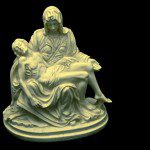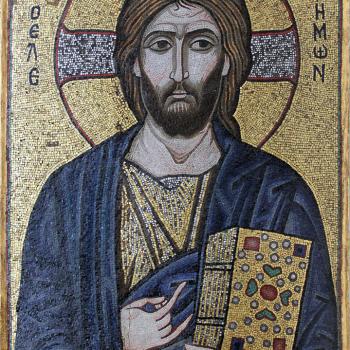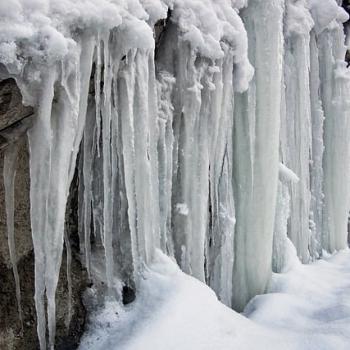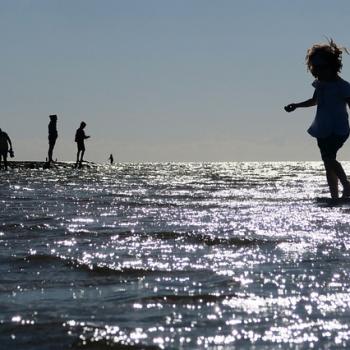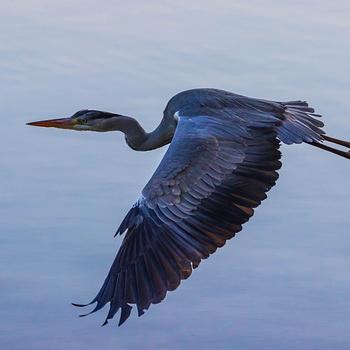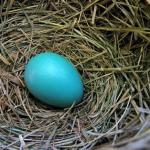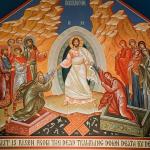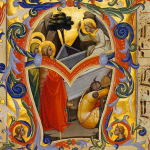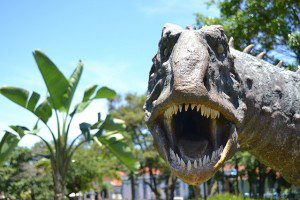
My husband is a devout bibliophile who has collected books his whole life; he still owns many of his beloved children’s picture books from the early 80s, and they have been passed on to my four-year-old daughter, Rose. Her favorite books to be read aloud are her father’s collection of joyless and cynical dinosaur stories.
This is a collection of about twenty stout, colorful, lavishly illustrated hardcover books, each telling the story of a day in the life of a non-personified dinosaur from a particular geological era, and there is not a pleasant page in the whole set. The writing, by one Rupert Oliver, is somehow both nihilistic and melodramatic; the plotting is miserable in the extreme. It’s as though a teenage Albert Camus decided to write a children’s book but was bad at it. The phrase “cries of anguish” is usually involved, as in “Brachiosaurus let out cries of anguish as the young megalosaurus sunk its teeth into her flesh.” And the books’ illustrations, by Andrew Howatt, follow suit, lovingly detailed paintings of oddly obese, plodding-footed and bulbous dinosaurs with facial expressions that can only be described as “anguished.” You, the reading audience, can purchase any of these morose volumes online; Rose’s favorite is the one entitled “Pleisiosaurus,” which can be gotten for a penny.
Last night, I discovered the worst volume in the whole set. This may be the most depressing thing I have ever read, and I have read the unabridged Les Miserables and six volumes of Tennessee Williams. The book is entitled “Dilophosaurus.” If there is a dinosaur with a name more difficult to say without crude Freudian slips than “Dilophosaurus,” I’d like to to meet him and exchange cries of anguish. Dilophosaurs pictured in Google images have jaunty red crests, but Andrew Howatt has chosen to paint his dilophosaurus with a sort of deformed drab tortoise shell on top of his head. The titular dilophosaurus in the book is only one of three dilophosaurs, so that clodhopper of a name is repeated at least a hundred times in the text. Our young antihero of a dilophosaurus wanders onto the beach on the first page of the book, hungry because he has not eaten in days. Fortunately, he spies a female pleisiosaurus who has beached herself in order to lay eggs. After an anguish-intense struggle, the dilophosaurus breaks the pregnant female’s neck and begins to tear her to bits. Sadly, at that point two other dilophosaurs appear and steal his catch. As Dilophosaurus wanders back into the jungle, the nearby island volcano explodes, covering the whole scene in a ball of black soot. Dilophosaurus sustains a serious burn on his leg from a falling piece of volcanic rock. Then he witnesses the other two dilophosaurs and the pleisiousaurus carcass washed away by a tsunami. He limps into the jungle, as hungry as ever.
Rose took great satisfaction in hearing this book read aloud. She laughed hysterically when I complained that the leg wound looked like a blob of red jelly. She was especially tickled by the phrase “the dinosaur sank his teeth into the warm flesh,” and begged me to “read it again, read it five times!” I read the line five times. I told her to go downstairs and tell her father she wanted “warm flesh” for supper. She came upstairs and cooked two of her potato heads on a pretend stove, so that she and I could eat “warm flesh.” Then she wanted the book read again.
Is there anything in the world more depressing than dinosaurs? Enormous, scaly, bad-tempered beasts that lived millions of years before we were born; half of them ate the other half with cries of anguish, and then a mysterious cataclysm wiped them out. How did they become beloved subjects of children’s books? Why is my fun-loving and well-adjusted four-year-old still giggling at the phrase “warm flesh?”
No doubt part of this is my horrible parenting. But perhaps it is also because my daughter is flesh. Rosie knows this; she knows, in her limited way, that everyone is going to die. Her best little friend across the street suffers from epilepsy. One day just a few months ago, we saw the ambulance come for him. His seizure went on too long, and his mother had to call for help. Rose watched from our sidewalk. Children see everything. Children are usually afraid, of something or other. The world is a fearful place.
People used to understand that fear was a normal experience. At the time the Grimm brothers were compiling their fairy tales, it was standard practice for all parents to tell their children a violent and frightening fairy tale before bed. You know the type– the version of Little Red Riding Hood where Red and the Grandmother are not found to be alive inside the wolf, or where two of the three little pigs are eaten and the wolf boiled to death. Snow White’s envious stepmother, you may recall, was tortured to death with white-hot shoes. The reason people told these stories to their children was that they believed that the children would have nightmares if they did not. Children were told scary stories awake so that their minds would not feel the need to tell scary stories while asleep. Fear is normal; best to get it over with in the controlled setting of a story. We will have our cries of anguish either way. Stories help us cope.
I will continue to read ghastly dinosaur books to my daughter as she requests them. I will also read fairy tales to her, both the classic horrifying versions and the colorful modern watering down. She may watch Harryhausen peplums and Godzilla movies with her father, and she may watch Power Rangers as long as we can afford a Netflix subscription. We live in a world of grace, true, but grace on this side of the veil will always be punctuated by cries of anguish. If my friend the existential dilophosaurus understood this, how much more should I?
(Image courtesy of pixabay)



